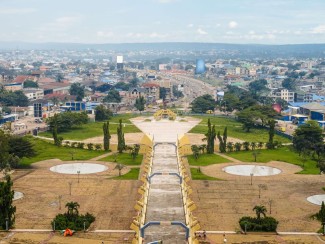Lao PDR Impact Story. Explore more impact stories here.
Key Results
- Through support from the Enhanced Integrated Framework (EIF), Lao People’s Democratic Republic (Lao PDR) National Implementation Unit (NIU) has been established and integrated into the Ministry of Industry and Commerce (MoIC). The NIU operates as the implementation hub for all Aid for Trade (AfT) projects in the country channelled through the MoIC. The NIU also serves as the secretariat for the national working group on the Trade and Private Sector Working Group, providing a blueprint for the Government to attract funding from development partners.
- Lao PDR provides a good example of strong country ownership and the EIF’s AfT effectiveness. Funding for NIU government staff in Lao PDR comes from the Government, while NIU project staff are sourced by various development partners implementing projects through the NIU Division. An overarching "Programme Executive Committee" oversees all AfT projects implemented by the MoIC, ensuring efficiency and increasing coherence.
Lao PDR is one of the youngest nations in Southeast Asia, with half of its population below the age of 25. Lao PDR’s economy experienced rapid growth of 7% on average for two decades until 2019. However, this has decreased in recent years to less than 3% due to COVID-19, high inflation, depreciation of the kip, and increases in the prices of imports and inputs (World Bank, 2022). Hydropower and mining remain the key drivers of the country’s economy, although significant efforts are underway to diversify into agriculture, agro-processing, tourism and manufacturing. Trade has been an engine for economic growth in Lao PDR. The country is on the pathway towards graduating from the least developed country (LDC) status in 2026.
According to Dr Manothong Vongsay, Vice Minister of Industry and Commerce, "EIF support is well grounded on the principle of national ownership, which helps the Government to promote its priority to enhance productive capacity, foster a well-balanced system for international trade, and achieve sustainable development in line with Lao PDR's National Socio-Economic Development Plan (2021-2025)."
Building structures and capacity for AfT coherence and efficiency
Since 2004, the EIF and its predecessor, the Integrated Framework (IF), have worked with the Government of Lao PDR to build a comprehensive and efficient framework for AfT harmonization and coordination, resource mobilization, and trade and private sector development. The Diagnostic Trade Integrated Study (DTIS) in 2006, and its subsequent updates in 2012 and 2022, have been used as key instruments for prioritizing the country’s trade development and resource mobilization efforts.
Following the DTIS in 2006 and its updates, the Government embarked on a journey leading to the current AfT governance framework. From an initial small start as a team within the Foreign Trade Policy Department, the MoIC progressively formalized the NIU as a division, culminating in the creation of a permanent home within the Department of Planning and Cooperation. This journey was mainly supported by the commitment from partners to implement a multi-donor trust fund through the NIU in Lao PDR, with the support of the EIF. With these structures in place, combined with evidence of effective implementation, Lao PDR successfully mobilized more than USD 187 million since 2006 – funded by Australia, the European Union, the Deutsche Gesellschaft für internationale Zusammenarbeit GmbH, Japan, the United States Agency for International Development, the World Bank, and others, to finance AfT-related projects. Out of this total, 22 projects were completed, amounting to USD 103 million, and a further nine projects are ongoing, amounting to USD 84 million. These projects, aimed at building trade capacity as well as fostering private sector development, were prioritized in all DTIS processes.
According to NIU Director Lattanaphone Vongsouthi, the EIF on its own is not a big source of funding. However, EIF funding "has made it possible for us to work strategically to garner support from other development partners who have supported EIFsupported proposals". She added that in some cases, the EIF has filled funding gaps left by partners. An example is the EIF project on improving the national industrial statistics system, metrology, and standardization to support policymaking and small and medium-sized enterprise (SME) development. Possibly the biggest effect has been setting up the structure and providing incentives and international commitment to greater efficiency and coherence, in line with the Paris Declaration on Aid Effectiveness. This provides a strong example of the catalytic role the EIF can play.
The training of senior officials in areas such as strategic planning, programme formulation, and trade and investment policy development has resulted in improved efficiency and fostered ownership and sustainability of the donor-funded projects in Lao PDR. Furthermore, the NIU effectively led the DTIS-informed multistakeholder processes of mainstreaming trade in the 9th National Socio-Economic Development Plan and the Development Strategy and Vision 2030. The participatory processes used in the development of the strategic plan resulted in strong local ownership and efficient implementation of programmes.
The NIU division also acts as the secretariat for the Trade and Private Sector Working Group (TPSWG), which was established with support from development partners, including the EIF. The EIF process facilitated the setting up of the National Trade Facilitation Committee (NTFC) and was instrumental in leveraging funding to support the TPSWG and NTFC. Multi-donor participation in the TPSWG allows for transparency, efficiency in programming and donor coordination.
The EIF has supported the MoIC’s development programme in three key areas. First, to deepen trade integration within the Association of Southeast Asian Nations (ASEAN) region, as most of the country’s trade is with neighbouring ASEAN member countries such as Vietnam and Thailand, or with China, including as part of the ASEAN-China Free Trade Agreement. The country has also focused on deepening trade integration into the World Trade Organization (WTO) since becoming a member in 2013.
The second key area is building an environment to promote ease of doing business; and the third, enhancing the competitiveness of local businesses to link them with lucrative regional and global markets.
“With EIF support, we have been able to reach some remote areas in the three northern provinces of Luangnamtha, Ouxomxay and Phongsaly,” says Vongsouthi. These areas are remote, but they present immense potential for growth if efforts to boost productivity in rice, maize and tea production, as well as the expansion of textile businesses, are successful.
Helping small businesses and establishing standards
Private sector development has been a long-standing strategy embedded in the DTIS processes, as supported by the EIF for Lao PDR. The NIU, through its role as the secretariat for the national working group on private sector development, has channelled support from the EIF and other partners to help SMEs and grassroots stakeholders improve their productive capacity and benefit from international trade.
Efforts to improve the competitiveness of Lao PDR products and services also resulted in the country attaining full membership in the International Organization for Standardization. The country’s Standards Division is fully equipped to serve as the WTO Technical Barriers to Trade Committee’s Enquiry Point. 400 new standards were adopted, and 500 certificates were issued during the course of the project from 2013 to2018. Domestic testing services are now accepted in international markets following the establishment of three laboratories, and the quality, safety and reliability of Lao PDR products and services is continuing to improve.
Strengthening competitiveness and productivity in the textile, maize, rice and tea sectors
Since 2019, the MoIC has been supporting women in six villages in the northern provinces of Luangnamtha, Ouxomxay and Phongsaly to produce more products, improve quality, and to link them to additional buyers and markets. The project’s success is a strong indicator of the EIF’s emphasis on creating more economic empowerment opportunities for women.
Additionally, support with business equipment, technical training (especially in natural dyeing techniques) for production groups, creative designs and better product pricing has enabled women to reach new markets and increase their incomes. A partnership with Ock Pop Tok (which means East Meets West), an artisan social enterprise, has highlighted the profile of Lao PDR’ textiles and opened new markets. To establish further market linkages, 25 videos were produced and distributed via social media. Furthermore, representatives from six villages were supported to attend domestic trade fairs, where they generated USD 4,000 in sales – a substantial amount given the context. These marketing efforts contributed to 11% of the average annual income for the six villages in 2021 and about 16% in 2022.
Along with improving the commercial value of traditional handicraft textiles, Lao PDR is working with local institutions and private sector firms to boost production and the quality of export products in the rice, maize and tea sectors.
In the Oudomxay province, the EIF funded training in the maize value chain for 36 producers and 12 micro-, small- and medium-sized enterprises, 4 of which were women-led. One batch of agricultural inputs provided to 36 maize farmers increased their productivity to 6-8 tons per hectare in the pilot phase. Meanwhile, three batches of inputs given to 210 rice farmers increased productivity by 4-5 tons per hectare in the first pilot phase and to 6 tons per hectare in the second phase. Production partnership groups, which link farmers to agro-processing firms in the maize and rice sectors, were established. In the Phongsaly province, support to the tea sector focused on improving product quality and packaging for the domestic market. 40 firms participated in training on exporting agricultural products, while 45 firms in each province were trained in business management skills and product packaging.
Removing trade barriers and sustaining growth
To promote business competitiveness, the EIF has supported the MoIC in the roll out of public-private dialogues (PPDs) to three northern provinces. PPDs were initiated by the Government in 2005 and seek to address operational challenges faced by businesses. Six rounds of local PPDs, supported by the EIF, led to the production of position papers and simplification of registration procedures to just three steps, which must be completed within 17 working days. This change translates to a 30% reduction in time, cost and paperwork for new business registration. This helped 907 new businesses register at reduced time and cost by 2020 and 1,070 businesses by 2021. Capacitybuilding for the national Chamber of Commerce is ongoing.
To conclude, EIF support to Lao PDR has led to several strong and tangible results. These include, first, the establishment of an AfT governance framework and coordination mechanisms, which have increased aid effectiveness and mainstreaming into the country’s economic development agenda; second, diversification and improved productivity for Lao PDR key products; and third, an improved business environment for small businesses to set up and operate. The AfT Governance Framework of Lao PDR and the PPD mechanism have worked effectively and could serve as a model for other LDCs to consider.
_ _ _
As the second phase of the Enhanced Integrated Framework (EIF) comes to an end in 2024, the objective is to produce a catalogue of impact stories showcasing the efforts of the EIF partnership in the least developed countries (LDCs) and recently graduated LDCs where it has been actively engaged. This impact story makes up one of the stories in the catalogue. Essential input and reviews were received from the country‑based EIF National Implementation Units (NIUs) and the wider EIF team.
The primary objective of each impact story, as well as the entire catalogue, is to adopt a journalistic approach in recounting the EIF's engagement in the LDCs during both Phase One and Two. The aim is to offer valuable insights and to document outcomes and impacts, as well as some lessons learned from the work of the EIF partnership in the LDCs. These stories do not provide a comprehensive overview of every aspect of EIF partnership engagement such as precise timelines or the exact extent of involvement (i.e., financial contributions). Instead, they serve as one of several means of information about the work of the EIF partnership. Interested readers are encouraged to supplement these impact stories by consulting other sources, including EIF Annual Reports, Trade for Development News articles, EIF social media channels, and, where applicable, the NIUs in the LDCs as well as the EIF Executive Secretariat.
It is essential to acknowledge that the information provided is neither exhaustive (e.g., it is based on the latest available data at the time of writing in 2023) nor evaluative in nature.
Lastly, while each impact story adheres to a similar structure, the diverse range of countries, contexts, and EIF engagements means that each story is unique.
If you would like to reuse any material published here, please let us know by sending an email to EIF Communications: eifcommunications@wto.org.



